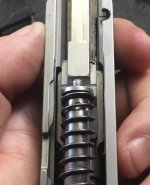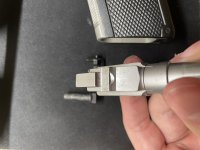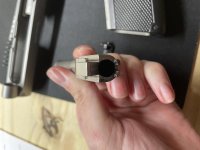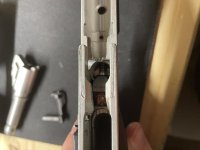Here's a couple older pics of my 4013TSW after it had fired 2500+ rounds. The barrel chamber (bottom) slams down onto the top of the frame as part of the normal operation. This can leave marks. Normal. FWIW, there are NO burred spots on the bottom of that 4013TSW barrel, and the markings left on top of the frame are normal,caused by normal cycling during live-fire.


The camming lugs on each side of the barrel engage with the frame camming lugs, which control the camming down/dropping and the release (upward). The aluminum frames show wear differently than steel frames (since aluminum is softer than steel, obviously).
While I'm not there to examine and inspect the OP's gun, I don't see anything on the frame in the pictures that would cause me undue alarm.
That said, it does appear that the barrel's machining left some rolled, burred edges on the bottom of the barrel chamber area, (to each side of the feed ramp). The one on the R/Side (if barrel were held with barrel hood facing UP) outer corner looks like something to which I'd take a red stone and dress it flat (deburring). Ditto on the other side, along the rear outer edge (very small burred spots raised along out edge in pic). Not filing, grinding or polishing. Just flattening and removing the raised, burred spots with a regular 6" red stone. (A file removes metal quickly, and it's easier to make mistakes.

)
Congrats on the gun and welcome to the forum.
Using oil or grease is up to you, but something needs to be present on the sides, tops and bottoms of the frame/slide rail grooves. Avoid excessive amounts, as excessive lube can cause its own problems. If the oil/grease is ozzing out and running down along the sides of the frame (next to the magazines), you're probably using too much?

I use a drop or two (small) on each side of the frame rails (which lubes the slide's rails); a large drop on the exterior of the barrel, spread around the barrel, from muzzle to top lug; a small drop on the front of the barrel hood; a small drop (or dab of grease) on each of the frame camming lugs; and any remaining oil or grease on my finger gets wiped around the guide rod. They also recommend adding a very small drop of oil to each side of the hammer's base, where it rotates/rubs within the frame (but don't make it so excessive that it will run off and spread around the rest of the inside of the frame). The bright/worn spots on the frame rails ought to be shiny and wet to the touch in a lubed pistol, but not so wet that the oil runs and drips off the frame, runs all over, etc.
Sometimes, if I'm going to be carrying ad using the gun in a harsh outside environment for an extended period (Coastal air and constant temperature changes, heavy humidity, etc) I'll mix a light slurry of a synthetic oil
and synthetic grease, so it stays put better, doesn't thin out, wick away, etc. (An old habit from my 1911 days.)
The factory recommended replacing the recoil & mag springs either every 5000 rounds fired, or every 5 years of service use (loaded, holstered), whichever came first. They said that was a conservative recommendation. Since I was carrying and shooting a lot of +P+ & +P loads in my 3rd gen's, I was a bit more conservative and tried to replace the recoil spring sooner than 5000rds (2500-3000rds) in my issued 6906 and personally owned 3913, since the higher pressure loads can accelerate normal wear & tear. I've found that
my mag springs seem to provide longer service if I replace the recoil spring a bit more often.










